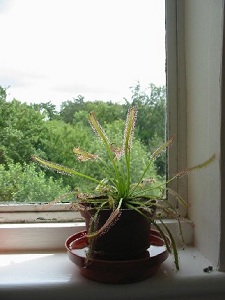
Growing Guides
Sundews
Drosera
Growing Sundews and Venus flytraps
Sundews and Venus flytraps are very easy to grow indoors, the sundew that most people grow is the Cape Sundew Drosera Capensis, which grows very easily. This plant grows in South Africa and does well on a bright windowsill. These plants would not survive frost so don't put them outside as there are other species which are frost hardy and even native to the UK, these include D.rotundifolia, D. anglica and D. longifolia. Another Sundew that you can grow indoors is D.aliciae which is also very easy to grow they also don't survive frost but they do do as well if not better in flowering department.

D.binata is another plant which is quite easy to grow. The best way of watering to plant is to have a tray of water beneath the plant pot which is at least 1cm deep at all times. Venus flytraps need similar conditions to D.Capensis
Growing from seed
How easy the plant is to grow from seed depends on how on the species: D. capensis is very easy to grow from seed and thrives anywhere if given enough water. D.binata is much harder and requires more delicate handling at most stages. For all species don't let the seedlings dry out as they die at even a small change in the amount of water. Growing from seed takes a lot of time and effort so if you don't have the time buy an adult plant.
Flowering
Sundews flower very easily and are very awarding. They are usually tiny pink or white flowers. The tallest D.aliciae with it's 3 foot tall stems can easily fall over but this is usually not a problem if you prop the stems up over the windowsill where the plant is growing and if it is a problem you can stake it halfway up. D.capensis and D.binata do not have this problem but this is a chance the greenfly have of making a meal on the stems and so be careful during flowering.
Potting up and Compost
Pot Sundews up in a mix of 50% sand 50% peat mix - this is the usual mix for general carnivorous composts. The plants are not very easy to propagate.
About
Copyright © Cambridge Carnivorous 2004 - 2015
Contact